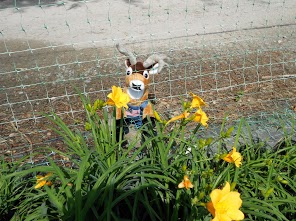
Deer are known to eat daylilies in the landscape. To prevent browsing, choose other plants or create a barrier with deer fencing.
Any seasoned gardener knows that even a well maintained garden will eventually face a pest issue. Pests come in all shapes and sizes and may include weeds, disease, insects, moles, rabbits, birds, and deer. Although some gardeners may invite wildlife into their gardens when that adorable deer eats your prized hydrangea it tends to lose the cuteness factor.
Regardless of what type of pest issue you are facing, the only way to establish a successful control program is to correctly identify and understand some basic things about the pest. Incorrect assumptions or misidentification can lead to taking the wrong action and may even cause more harm to plants.
Some things to know about your pest (after identification):
- Preferred host or target plant – diversify landscapes to minimize susceptibility to each pest.
- Feeding/damage caused – is it just aesthetic or will it cause long-term harm?
- For rapidly reproducing pests such as insects or fungi, what is the timing of new generations? For example, if you eliminate adult insects expect that eggs are waiting to hatch – you need to know when to retreat.
- What natural enemies might help reduce populations and how can they be preserved?
- Be sure to match control methods with pest behavior and activity. For example, if you want to use an insecticidal soap on azalea lace but you need to know that they feed from the underside of the leaf in order to properly coat them with the product.
Take the time to get to know the pest in your backyard and management efforts will be much more effective. For help with identification and control, contact your local extension office.
Latest posts by Julie McConnell (see all)
- 2024 Gardening in the Panhandle LIVE! Palm Selection and Care - March 14, 2024
- Local Youth Invited to Participate in Junior Jubilee Watermelon Contest! - March 11, 2024
- Rainfall Revives Resurrection Fern - February 8, 2024
